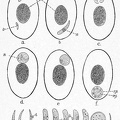(a) Cell of the asexual generation of the cryptogam Pellia epiphylla: the nucleus is about to divide, a polar ray-formation is present at each end of the spindle-shaped nucleus, the chromosomes have divided into two horizontal groups each of sixteen pieces: sixteen is the number of the chromosomes of the ordinary tissue cells of Pellia. (b) Cell of the sexual generation of the same plant (Pellia) in the same phase of division, but with the reduced number of chromosomes—namely, eight in each half of the dividing nucleus. The completed cells of the sexual generation have only eight chromosomes. (c) Somatic or tissue cell of Salamander showing twenty-four ∨-shaped chromosomes, each of which is becoming longitudinally split as a preliminary to division. (d) Sperm-mother-cell from testis of Salamander, showing the reduced number of chromosomes of the sexual cells—namely, twelve; each is split longitudinally. (From original drawings by Prof. Farmer and Mr. Moore.)
- Author
- The Kingdom of Man
By Sir E. Ray (Edwin Ray) Lankester
Published 1907
Available from gutenberg.org - Posted on
- Sunday 8 November 2020
- Dimensions
- 900*1058
- Tags
- Albums
- Visits
- 523
- Downloads
- 43
 Download Photo
Download Photo





